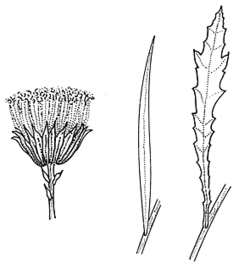Common name: Fireweed
Senecio madagascariensis Poir. APNI* Synonyms: Senecio sp. K sensu Jacobs & Pickard (1981) p.p. APNI*

Description: Annual or biennial herb, 20–60 cm high, mostly erect, sometimes much-branched, glabrous or sparsely hairy.
Leaves variable, narrow-lanceolate to elliptic or oblanceolate, 2–7 cm long, 3–10 mm wide, margins entire or variously toothed or rarely upper leaves pinnatifid, lamina glabrous, base tapered, stem-clasping and often auriculate in upper leaves.
Inflorescence loosely corymbose, heads usually 2–10 heads; heads narrow-campanulate, 3.5–4 mm diam., ± glabrous; involucral bracts 19–21, 4–5 mm long; bracteoles 8–12. Ray florets mostly 13–15; ligules 6–10 mm long.
Achenes 1.5–2.5 mm long, brown; pappus 4–6.5 mm long.
Flowering: chiefly spring–autumn.
Distribution and occurrence: Widespread opportunistic weed, especially in degraded pasture and disturbed sites, in coastal districts, north from Bega and west to Dubbo area. Native of South Africa.
NSW subdivisions: *NC, *CC, *SC, *NT, *CT, *ST, *NWS, *CWS, *SWS, *NWP, *SWP
Other Australian states: *Qld
A declared noxious weed in some shires. Toxic to cattle and horses if eaten.
Text by G. J. Harden
Taxon concept: Flora of NSW 3 (1992)
APNI* Provides a link to the Australian Plant Name Index (hosted by the Australian National Botanic Gardens) for comprehensive bibliographic data
***The AVH map option provides a detailed interactive Australia wide distribution map drawn from collections held by all major Australian herbaria participating in the Australian Virtual Herbarium project.
|


